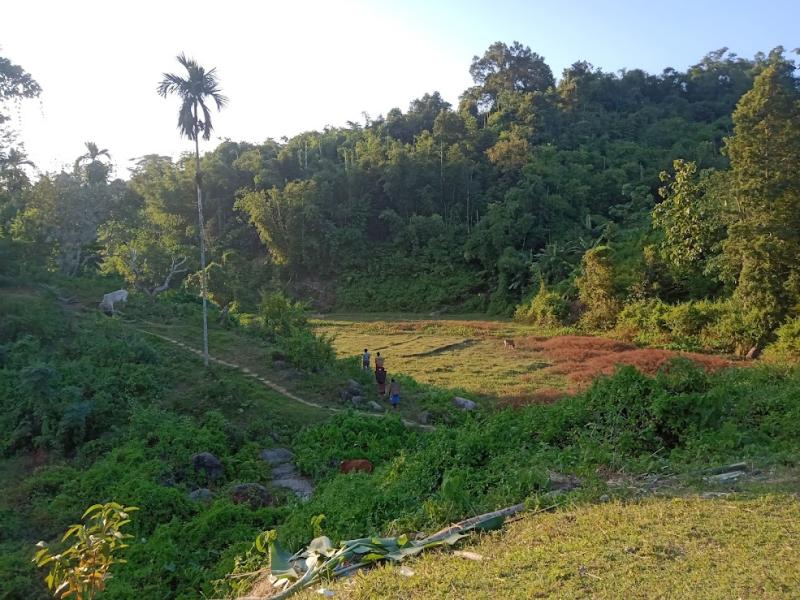It was June 5, 2023. A scorching sunny day in Rongtara- a pristine, hilly village belonging to Karbi people of Kohora River Basin in Karbi Anglong district of Assam. A team of research scholars of Aaranyak, a scientific and industrial research organisation, was trekking the hills of the remote village as part of their regular field-survey on mammals.
A section of the villagers too, accompanied the team and engaged in conversation on mammals and their behaviour that live in their locality. Suddenly, one of the villagers picked up a dead rodent- Jukikso, as they call it in Karbi language, lying on the Jhum field near a bamboo bush to show it to the team members.
And it instantly turned into an awe-moment for the research team. To their pleasent surprise, the team members found that the mouse to be the Asiatic Long-tailed Climbing Mouse (Vandeleuria oleracea), a rarely seen rodent species with a cream-brown colour. Thus, the team recorded the second locality of the rodent species in Assam in Rongtara village. The first locality of the rodent in the state was recorded in Angarkhata village of Kamrup district in 1961.
The villagers told the team that the species that live on bamboo grooves, is rarely sighted in their locality. Residents of Rongtara, a small Karbi village with 19 households, survive on traditional Jhum cultivation, clearing the jungles on rotating cycles. They grow multiple crops including different types of vegetables, chilli, sorghum etc, along with traditional rice varieties. It takes three hours trekking along the hilly trails to reach the village from Kohora.
“Vandeleuria oleracea (Bennet, 1832) is a ‘Least Concern’ species as stated by IUCN, belonging to the genus Vandeleuria, and found in Southern and Southeastern Asia (Aplin & Molur 2017)”, says Sourav Gupta, a researcher with Aarnyak and a PhD scholar in Life Science and Bioinformatics in Assam University.
Photo Curtesy Sourav Gupta
A tree climber, the rodent is an indicator of sustained and healthy natural habitat and plays a vital role in food-chain, he adds.
Since the moment, it took few months for the team for further study and finally to publish their findings in the “Journal of Threatened Taxa” (http://www.threatenedtaxa.org.) an international journal on conservation and all associated field, on its September 26, 2023, issue to establish recognition of the specie’s locality.
Gupta is the lead author of the paper titled “New locality record of the Asiatic Long-tailed Climbing Mouse Vandeleuria oleracea (Bennet, 1832) (Mammalia: Rodenta: Muridae) from Kohora River Basin, Assam, India”. Jayanta Kumar Roy, Ecosystem Specialist, Aaranyak; M. Firoz Ahmed, Head, Tiger Research and Conservation Division of Aaranyak; Ramie H. Begum, Department of Life Science and Bio-informatics of Assam University Diphu Campus, Karbi Anglong and Shyamkant S. Talmale, Zoological Survey of India, Western Regional Centre, Vidyanagar in Maharashtra are the co-authors of the paper.
 A view of Rongtara village (Photo-Sushanta Talukdar)
A view of Rongtara village (Photo-Sushanta Talukdar)
Gupta says that the climbing mouse measured 60.66 mm in head and body length. The tail lengt was 100.31 mm. The hindfoot was 14.12 mm and the ear length was 11.35 mm.
“The mouse was found dead in the Jhum plantation near a bamboo clump. We also conducted a series of informal interviews among the villagers and showed them photographs of the species. They told us that the species is rarely seen in the forest,” Gupta adds.
In Rongtara village, the species inhabits in traditional Jhum cultivation areas and near secondary bamboo forests. This species is arboreal and exhibits nocturnal behaviour. Its food species consist of fruits, buds, and flowers; he further adds.
“The new site record from Rongtara Village is approximately 215 km from the earlier report by Ellerman (1961), the paper states.
Gupta says that more study on ecology and habitat of the species required to understand its species’ habitat requirements. Studies involving an integrate taxonomic approach including phylogenetic studies will help resolve this species complex, he feels. The small mammals are very poorly known in the extensive northeast region. Exploring systematically is need of the hour and that is what our team is doing at this moment.
“The small mammals are very poorly known in the extensive northeast region. Exploring systematically is need of the hour and that is what our team is doing at this moment,” says M Firoz Ahmed, who also leads the Natural Resource Management Programme of the organisation.